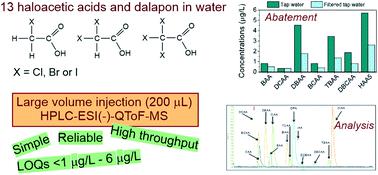当前位置:
X-MOL 学术
›
Environ. Sci.: Water Res. Technol.
›
论文详情
Our official English website, www.x-mol.net, welcomes your feedback! (Note: you will need to create a separate account there.)
High-throughput and reliable determination of 13 haloacetic acids and dalapon in water and evaluation of control strategies
Environmental Science: Water Research & Technology ( IF 5 ) Pub Date : 2020-05-26 , DOI: 10.1039/d0ew00296h Cristina Postigo 1, 2, 3, 4, 5 , Pere Emiliano 5, 6, 7, 8 , Fernando Valero 5, 6, 7, 8
Environmental Science: Water Research & Technology ( IF 5 ) Pub Date : 2020-05-26 , DOI: 10.1039/d0ew00296h Cristina Postigo 1, 2, 3, 4, 5 , Pere Emiliano 5, 6, 7, 8 , Fernando Valero 5, 6, 7, 8
Affiliation

|
A simple, fast, highly-sensitive and selective method for the determination of 13 HAAs and dalapon in water has been optimized and validated. The method is based on large volume injection (200 μL) and analyte determination with liquid chromatography coupled to negative electrospray ionization-high resolution mass spectrometry (LVI-LC-ESI(−)-HRMS). High throughput is possible due to minimum sample manipulation and short analysis time (16 min in total). This is the first analytical LC-MS-based method that covers the whole suite of HAAs for which analytical standards are available and dalapon, and thus, represents a less costly option than ion-chromatography-based technologies developed for the same purpose. The method provided satisfactory trueness (91–120%) and precision (<17%) values for all analytes, except for CAA. Matrix effects, always in the form of ionization suppression effects, were not relevant (<25%), except in the case of CAA, and they were all well compensated with the use of internal standard calibration. This methodology allows quantifying HAAs in tap waters at concentrations below 1 μg L−1, except in the case of DBCAA and TCAA (3 μg L−1) and CAA and DCBAA (6 μg L−1). Thus, the presented analytical approach is satisfactory for the routine monitoring of HAA5 in drinking waters and obtaining additional knowledge on the formation and occurrence of other HAAs and dalapon that may be of relevance to ensure the provision of safe drinking water in the future. The concentrations of some of the brominated HAAs in chlorine-quenched disinfected water stored in the dark at −20 °C for seven days decreased between 26 and 46%, and thus, water samples should be analysed within 24 hours of their collection. As part of the validation method, the optimized approach was applied to evaluate two strategies to control HAA concentrations in water, i.e., lowering the water pH during the coagulation-flocculation step to improve process efficiency and using a household water pitcher filtration unit to remove HAAs in tap water.
中文翻译:

高通量可靠测定水中的13种卤代乙酸和lapapon及其控制策略的评估
优化和验证了一种简单,快速,高度灵敏和选择性的测定水中13种HAAs和lapapon的方法。该方法基于大体积进样(200μL)和液相色谱与负电喷雾电离高分辨率质谱(LVI-LC-ESI(-)-HRMS)结合进行分析物测定的方法。由于最少的样品操作和较短的分析时间(总共16分钟),因此可以实现高通量。这是第一种基于LC-MS的分析方法,涵盖了适用于分析标准品和dalapon的整套HAA,因此与出于相同目的而开发的基于离子色谱的技术相比,它是一种成本更低的选择。该方法为所有分析物(CAA除外)提供了令人满意的真实度(91–120%)和精度(<17%)值。矩阵效果 总是以电离抑制作用的形式出现,不相关(<25%),除非是CAA,并且都可以通过使用内标校准得到很好的补偿。该方法可对自来水中浓度低于1μgL的HAAs进行定量-1,除了DBCAA和TCAA(3μgL -1)和CAA和DCBAA(6μgL -1)以外。因此,所提出的分析方法对于常规监测饮用水中的HAA5以及获得有关其他HAA和dalapon的形成和发生的更多知识可能是令人满意的,这些知识可能与确保将来提供安全饮用水有关。在黑暗中于-20°C暗处贮藏了7天的经氯骤冷的消毒水中的某些溴化HAAs的浓度降低了26%至46%,因此,应在收集水样后24小时内对其进行分析。作为验证方法的一部分,采用了优化方法来评估两种控制水中HAA浓度的策略,即,在混凝-絮凝步骤中降低水的pH值以提高工艺效率,并使用家用水罐过滤装置去除自来水中的HAAs。
更新日期:2020-05-26
中文翻译:

高通量可靠测定水中的13种卤代乙酸和lapapon及其控制策略的评估
优化和验证了一种简单,快速,高度灵敏和选择性的测定水中13种HAAs和lapapon的方法。该方法基于大体积进样(200μL)和液相色谱与负电喷雾电离高分辨率质谱(LVI-LC-ESI(-)-HRMS)结合进行分析物测定的方法。由于最少的样品操作和较短的分析时间(总共16分钟),因此可以实现高通量。这是第一种基于LC-MS的分析方法,涵盖了适用于分析标准品和dalapon的整套HAA,因此与出于相同目的而开发的基于离子色谱的技术相比,它是一种成本更低的选择。该方法为所有分析物(CAA除外)提供了令人满意的真实度(91–120%)和精度(<17%)值。矩阵效果 总是以电离抑制作用的形式出现,不相关(<25%),除非是CAA,并且都可以通过使用内标校准得到很好的补偿。该方法可对自来水中浓度低于1μgL的HAAs进行定量-1,除了DBCAA和TCAA(3μgL -1)和CAA和DCBAA(6μgL -1)以外。因此,所提出的分析方法对于常规监测饮用水中的HAA5以及获得有关其他HAA和dalapon的形成和发生的更多知识可能是令人满意的,这些知识可能与确保将来提供安全饮用水有关。在黑暗中于-20°C暗处贮藏了7天的经氯骤冷的消毒水中的某些溴化HAAs的浓度降低了26%至46%,因此,应在收集水样后24小时内对其进行分析。作为验证方法的一部分,采用了优化方法来评估两种控制水中HAA浓度的策略,即,在混凝-絮凝步骤中降低水的pH值以提高工艺效率,并使用家用水罐过滤装置去除自来水中的HAAs。



























 京公网安备 11010802027423号
京公网安备 11010802027423号